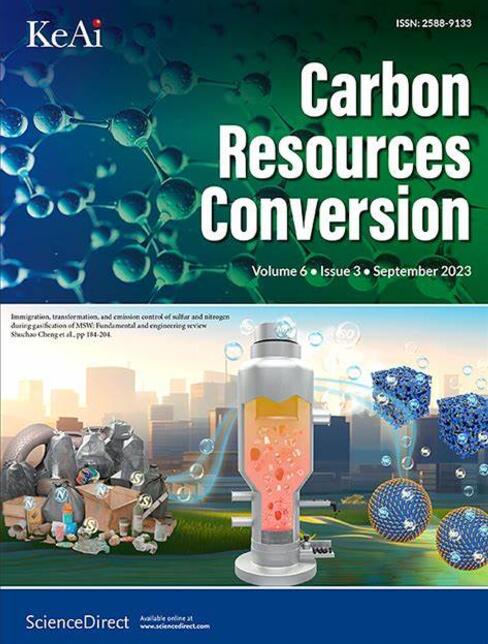Research on the process of naphtha hydrocracking to chemical materials
IF 7.5
3区 环境科学与生态学
Q2 ENERGY & FUELS
引用次数: 0
Abstract
To systematically study the conversion process of paraffin, cycloalkane, and aromatic on ZSM-5 molecular sieve in naphtha hydrocracking, a series of related experiments were carried out based on the prepared hydrocracking catalyst, Catalyst-HC. Ni and ZSM-5 molecular sieve were selected as the hydrogenation active component and the cracking component of Catalyst-HC, respectively. The results obtained through this work indicate that on ZSM-5 molecular sieve, the paraffin and cycloalkane in naphtha are mainly convertible hydrocarbons. The higher the content of convertible hydrocarbons in naphtha, the easier it is for the conversion reaction to occur. As C5+ conversion rate rises, the yields of paraffin and cycloalkane decline, and the yields of aromatic and aromatic-carbon in product-naphtha remain almost unchanged. The aromatic-average carbon-number (CN) in product-naphtha changes very little, decreasing from 8.3 to 8.2. This means that almost no aromatic undergoes the saturation reaction or conversion reaction on Catalyst-HC. Due to the small pore size of ZSM-5, C5+ i-paraffin has a lower conversion rate and a higher average CN compared to C5+ n-paraffin. Meanwhile, as C5+ conversion rate gradually rises from 0 to 23 %, the average CN drop-values of C5+ n-paraffin and C5+ i-paraffin are 1.3 and 0.14, respectively. C5-ring cycloalkane-ring-carbon (C5-ring CRC) is more likely undergoing ring-opening (RO) reaction than that of C6-ring cycloalkane-ring-carbon (C6-ring CRC). The conversion rate of C5-C7 cycloalkane is higher than that of C8+ cycloalkane, and the former bears a higher jump-value compared to the latter with the increase of C5+ conversion rate. Unlike paraffin and aromatic, the average CN of cycloalkane gradually rises with the increase of C5+ conversion rate.

石脑油加氢裂化制化工原料工艺研究
为系统研究石脑油加氢裂化过程中石蜡、环烷烃和芳烃在ZSM-5分子筛上的转化过程,以制备的加氢裂化催化剂catalyst - hc为基础,进行了一系列相关实验。选用Ni分子筛和ZSM-5分子筛分别作为催化剂的加氢活性组分和裂化组分。研究结果表明,在ZSM-5分子筛上,石脑油中的石蜡和环烷烃主要为可转化烃。石脑油中可转化烃的含量越高,越容易发生转化反应。随着C5+转化率的提高,石蜡和环烷烃的产率下降,产物石脑油中芳烃和芳烃的产率基本保持不变。产物石脑油的芳烃平均碳数(CN)变化不大,由8.3降至8.2。这意味着在hc催化剂上几乎没有芳香族发生饱和反应或转化反应。由于ZSM-5的孔径较小,与C5+ n-烷烃相比,C5+ i-烷烃的转化率较低,平均CN值较高。同时,随着C5+转化率从0逐渐上升到23%,C5+正构烷烃和C5+正构烷烃的CN平均下降值分别为1.3和0.14。c5环环烷烃-环碳(c5环CRC)比c6环环烷烃-环碳(c6环CRC)更容易发生开环(RO)反应。C5- c7环烷烃的转化率高于C8+环烷烃,且随着C5+转化率的增加,C5- c7环烷烃的跳跃值高于C8+环烷烃。与烷烃和芳烃不同,环烷烃的平均CN随着C5+转化率的提高而逐渐升高。
本文章由计算机程序翻译,如有差异,请以英文原文为准。
求助全文
约1分钟内获得全文
求助全文
来源期刊

Carbon Resources Conversion
Materials Science-Materials Science (miscellaneous)
CiteScore
9.90
自引率
11.70%
发文量
36
审稿时长
10 weeks
期刊介绍:
Carbon Resources Conversion (CRC) publishes fundamental studies and industrial developments regarding relevant technologies aiming for the clean, efficient, value-added, and low-carbon utilization of carbon-containing resources as fuel for energy and as feedstock for materials or chemicals from, for example, fossil fuels, biomass, syngas, CO2, hydrocarbons, and organic wastes via physical, thermal, chemical, biological, and other technical methods. CRC also publishes scientific and engineering studies on resource characterization and pretreatment, carbon material innovation and production, clean technologies related to carbon resource conversion and utilization, and various process-supporting technologies, including on-line or off-line measurement and monitoring, modeling, simulations focused on safe and efficient process operation and control, and process and equipment optimization.
 求助内容:
求助内容: 应助结果提醒方式:
应助结果提醒方式:


